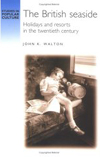Author's response
| Book: | The British Seaside: Holidays and Resorts in the Twentieth CenturyJohn K. WaltonManchester University Press ISBN: 0719051703, pp. vii + 216, 2005 |
| Reviewer: | Barry Doyle |
I must begin by thanking Barry Doyle for his positive, thorough and thoughtful review of The British Seaside. My reservations and ripostes deal mainly with detailed points of emphasis and interpretation rather than with the broad sweep of his comments.
Two general points may be made, however. The first is about 'cultural history'. My intention was to incorporate new perspectives involving discourses and representations, rather than to organise the book around them. So 'cultural history' perspectives fit into the argument where it seemed appropriate, playing an important role in the introduction as part of the attempt to explain the continuing resonance and (in a sense) popularity of the seaside, and taking centre stage again in (as Doyle remarks) the entertainment chapter, while inflecting the text from time to time elsewhere. The bulk of the analysis does indeed treat 'standard' (because important) themes, but in contexts which have largely been excluded from the dominant agenda. Part of the book's claim to originality is the pursuit of established themes in new settings and with a distinctive angle of vision. Given these intentions, the element of criticism in the comment that the book concentrates on 'the historiographical orthodoxy and themes which Walton claims his book challenges' reads rather uneasily, especially as the challenge was more to ideas that the history of resorts and tourism was somehow frivolous than to established ways of approaching urban history 'in the round'.
Secondly, the north/south question must be addressed. In some ways I think Doyle is on firmer ground here. The bias of my research is loaded towards northern locations, and I would have liked to spend more time on interesting potential case-studies like Margate or indeed Bournemouth. But the suggestion that I have a 'model' seaside resort in mind, which looks more like Blackpool or Morecambe (perhaps) than Weston-Super-Mare or Paignton, reads like caricature, especially when praise is offered elsewhere for the book's coverage of the sheer diversity of British resort environments. Where are these resorts whose sea frontages are dominated by white blocks of flats? Parts of Brighton and Hove, for example, or parts of Eastbourne, fit this bill. But I think the contrast is overdone, and what continues to impress me is the limited extent of this kind of (re)development in Britain as opposed to the situation in 'mainland' Europe. I would be glad to see an extended treatment of this idea, however, testing the suggestion against the evidence on the ground; and to that extent, at least, this is a fruitful criticism.
A few more specific issues remain. I do not suggest, and would not suggest, that either the British seaside or the cotton industry had their origins in the mid-nineteenth century, and I hope this was a misprint for eighteenth. Nor do I believe that 'the decline of railways was central to the collapse of the resorts': adjustment to the motor vehicle posed new problems which sometimes produced damaging or at least problematic attempts at solutions, but this is not the same thing. Indeed, I am if anything optimistic about the resilience and capacity for regeneration of many British seaside resorts. And there is a lot more to the problem of 'decline' than the opportunities proffered by 'affluence', as I hope the book makes clear at several points. I am not conscious of having been unfair to Brighton (Morecambe might have a stronger case for complaint, and indeed did complain, though on the basis of a distortion of a radio interview!): the source of this perception may well be my use of an interesting Queens Park pamphlet on Brighton to illustrate a distinctive kind of critique of resort local government from the socialist Left. I think Bournemouth is actually the most under-represented resort in the book, in relation to its size and importance, and (to return to an earlier theme) in an ideal world I would certainly have liked to do more local research on South Coast case-study towns. Finally, I am well aware that seaside towns became retirement destinations for former holidaymakers who associated them with happy summers in their younger days. This point is emphasised in my chapter in G. Shaw and A. Williams (eds.), The rise and fall of British coastal resorts (Pinter, 1997), and I might have driven it home more strongly here. The key problem, of course, is that such an influx changes the nature of the resorts it invades, and inhibits investment in new development to keep pace with the changing tastes of mainstream or desirable markets. But I do not think I have been unduly negative about seaside retirement.
To reiterate, however, I am gratified with the overwhelmingly positive tone of this review, and I share Barry Doyle's hope that the book will stimulate case-studies, which will test its ideas in a variety of settings and shift the agenda for a revised synthesis, based on greater depth of coverage, at some point in the future.

